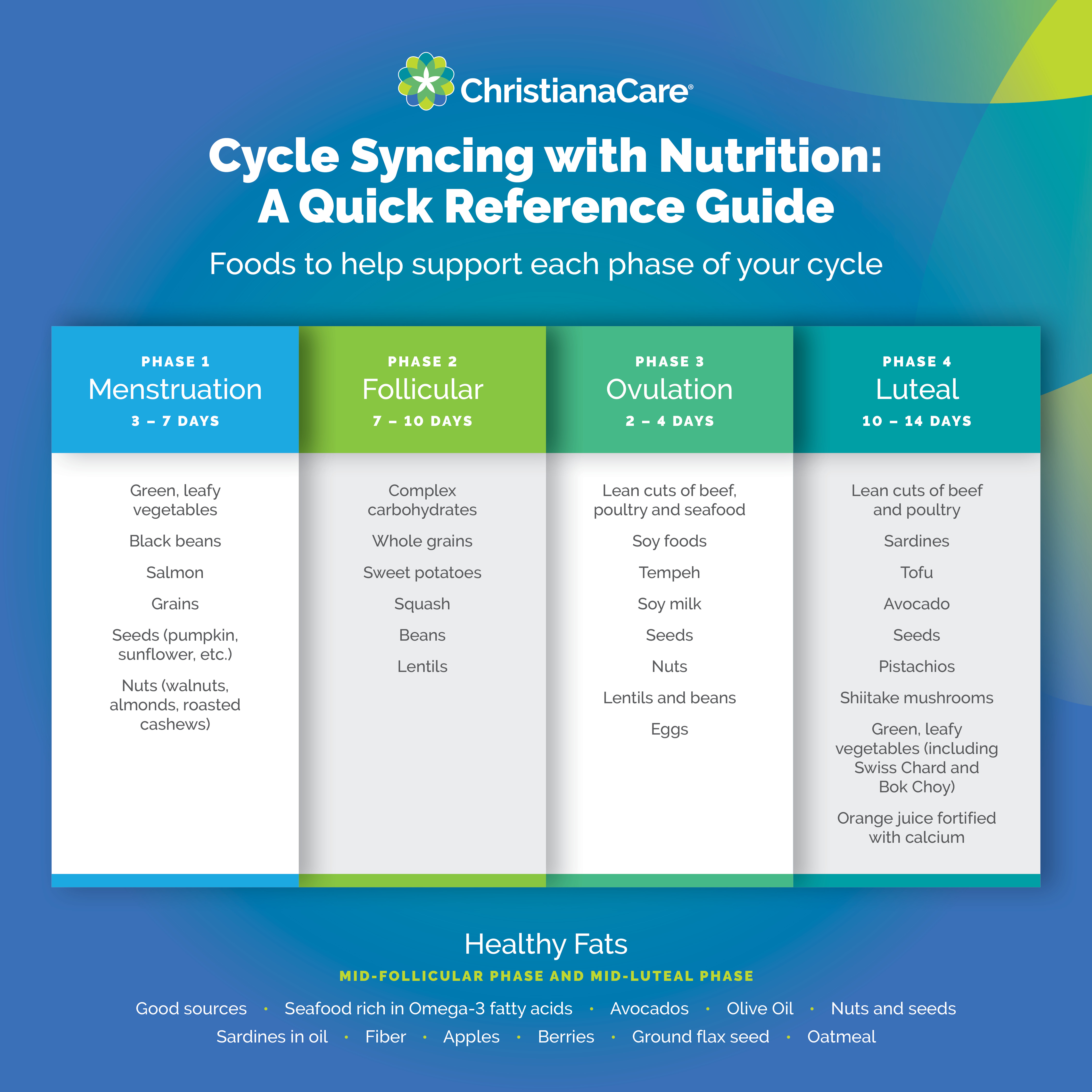You’ve probably heard of – or experienced for yourself – that women crave chocolate due to PMS (premenstrual syndrome) before or even during their cycle. Some attribute this craving to a loss of riboflavin during this time. But it could also be a response to the body’s increase in hormones that contribute to cravings for sweets and fats, and chocolate has both! Ignoring those cravings isn’t going to work. However, there are ways to satisfy your body’s needs without breaking the calorie bank, overindulging in food or reaching for unhealthy options.
The cycle
There are essentially two phases in the menstrual cycle — follicular and luteal — which are triggered by hormonal changes. “Cycle syncing” is the process of altering diet and activity according to a woman’s naturally occurring menstrual phases each month.
When to Seek Care
Women may have menstrual-related conditions needing treatment beyond lifestyle changes alone. Seek care for:
– Irregular periods (not due to medication or breastfeeding).
– Heavy menstrual bleeding or severe menstrual pain.
– Significant depression and/or anxiety around the menstruation cycle.
Schedule an appointment with us online.
When you consider nutrition “cycle syncing,” which is tailoring your nutrition with your menstrual cycle throughout the month, it’s helpful to break it into four separate components:
- Menstruation (beginning of menstruation).
- Follicular.
- Ovulation (1st day of luteal).
- Luteal.
What does this mean? It means this complex cycle is controlled by female hormones that cause regular bleeding (periods). Estrogen is one of the major players that helps regulate a woman’s menstrual cycle and is produced mainly by the ovaries, the same two small glands that store hundreds of thousands of tiny eggs for release over a woman’s lifetime.
Download the below infographic to your phone for nutrition ideas that may help with your symptoms! 
Eating for PMS in cycle stages
Phase 1: Menstruation – “Aunt Flo” comes to visit (3 – 7 days)
During the menstrual period, the most work happens during the first three days. This is when a woman’s flow arrives and pain onsets in the pelvis, legs, back and other areas. This is also when the most blood is lost. The cramps a woman feels serve a purpose. They are a symptom of the uterus contracting, helping to shed the endometrium (the lining of the uterus), which you may know as Aunt Flo coming to visit, also known as menstrual bleeding.
Focusing on good sources of nutrition with magnesium in them may help reduce the severity of symptoms for better sleep, headaches, muscle soreness in the uterus and cramping, swelling and bloating and mood changes.
What to eat
| Green, leafy vegetables | Salmon | Seeds (pumpkin, sunflower, etc.) |
| Black beans | Grains | Nuts (walnuts, almonds, roasted cashews) |
Healthy fats
Healthy fats can be useful during this phase since levels of estrogen and progesterone are typically low. We need healthy fats to help generate any kind of hormones. Look for good sources of healthy fats in seafood rich in omega-3 fatty acids, avocados, olive oil, sardines in oil, nuts and seeds, fiber, apples, berries, ground flax seed and oatmeal.
Meals on the go? Go healthy! Check out these recipes from our Health & Wellness blog for easy meal ideas for days when you’re trying to eat healthy and in line with your cycle but have no time!
Phase 2: Follicular – release the kraken! (7-10 days)
Let’s face it, during the second stage of a woman’s cycle, your body is about to drop the mic! Well, not the mic per se, but your body is preparing to release an egg. That’s a lot of work. During this phase, hormones are released to signal the production of follicles on the surface of an ovary. A handful will enlarge, but only the largest and strongest follicle will ultimately release an egg during ovulation. This plays the biggest role in the length of your cycle.
At the very same time, the endometrium starts to thicken in case you’re getting ready to have a baby. The last five days of this phase, plus the ovulation day (the day the egg drops), are your fertile window (baby-making time!). This is when you are most likely to become pregnant if you have sexual intercourse without using birth control.
Focus on complex carbohydrates during this phase. Complex carbohydrates keep the insulin-glucagon ratio even and can help manage depression, fatigue and insomnia.
What to eat
| Whole grains | Squash | Lentils |
| Sweet potatoes | Beans |
Pro Tip: Between cycling – zinc can be helpful for ovulation and potentially help to support the egg quality. For women who are looking to conceive, they may want to consider using more zinc in their diet or with a supplement leading up to the follicular phase. Talk with your healthcare provider to see if this is a helpful option for you.
Phase 3: Ovulation phase – there can be only one! (2-4 days)
The three to five days leading up to ovulation and the day of ovulation itself, are the most fertile. Ovulation begins on the day the egg is released from the egg follicle on the ovary. Remember when you were little and found a dandelion seedling in the grass? You grabbed it and blew on the seedlings to release them into the wind. This is similar except it’s just one egg being released.
Protein is your friend during this phase. Protein will help keep your blood sugars steady, keep you feeling full and prevent cravings.
What to eat
| Soy foods | Seeds | Lentils and beans |
| Tempeh | Nuts | Eggs |
| Soy milk | Lean cuts of beef, poultry and seafood |
Phase 4: Luteal (premenstrual) phase – winter is coming! (10-14 days)
The luteal phase starts on the day the egg drops, also known as ovulation day. This happens anytime from day 7 to day 22 of a normal menstrual cycle. After the teen years and before perimenopause (the time before menopause), the luteal phase is very predictable. It normally lasts 13 to 15 days from ovulation until menstrual bleeding starts a new cycle. These two weeks are also known as the premenstrual period.
It’s very common to have symptoms during all or part of the luteal phase. You may feel irritable and cranky, gain water weight and feel bloated. A day or more before your period, you may start to have pain (cramps) in your belly, back or legs. It’s normal to have less energy at this time. Don’t panic, and don’t get down on yourself for needing to rest or nap. You may also have headaches, diarrhea or constipation, nausea or dizziness.
When premenstrual symptoms make your daily life difficult, you are said to have premenstrual syndrome (PMS). Good dietary sources during the luteal phase should include calcium. Calcium can help reduce the severity of PMS symptoms, including bloating, depression, pain, mood swings and food cravings.
Pro tip: It may be difficult to get all the calcium necessary to help with general PMS symptoms. While we recommend getting as much calcium as possible in your diet, check with your health care provider for guidance on nutrition and supplementation. According to the American College of Obstetricians and Gynecologists, 1200 milligrams of magnesium is usually recommended to help reduce the physical and mood symptoms of PMS. Everyone metabolizes food and supplementation differently. Results will vary.
What to eat
| Lean cuts of beef and poultry | Avocado | Shiitake mushrooms |
| Sardines | Seeds | Green, leafy vegetables (including Swiss Chard and Bok Choy) |
| Tofu | Pistachios | Orange juice fortified with calcium |
Iron
Consider increasing iron and iron sources, especially during the luteal phase leading up to the menstruation phase. The leading cause of iron deficiency and anemia is a woman’s cycle. The more that women boost their iron stores before their menstruation cycle, the better. Look to increase iron consumption through animal sources, legumes or fortified cereals. Some women might need supplementation or other medical interventions. Sometimes, other conditions cause heavy menstrual cycles or reasons for medical intervention.
Follow up with your health care provider
Menstrual cycles can have many different symptoms and associated medical conditions. Making lifestyle modifications is helpful, but if you’re experiencing severe or concerning symptoms, these should always be discussed with a healthcare provider.
Learn more about our obstetrics and gynecology (OB-GYN) health care and support online and schedule an appointment with one of our expert health care providers today.



